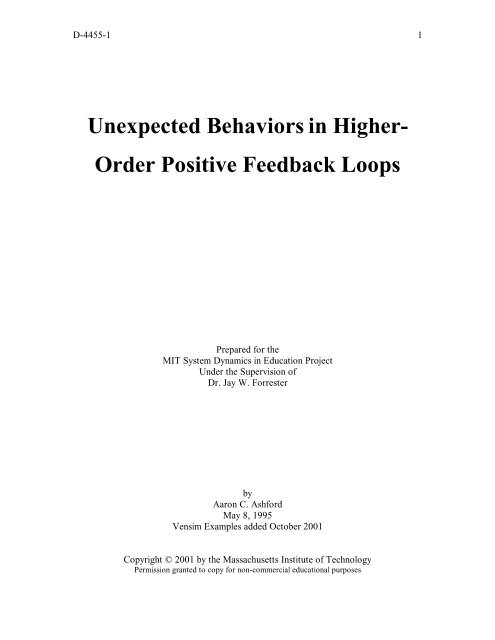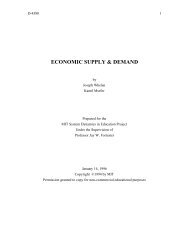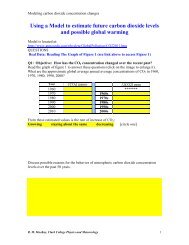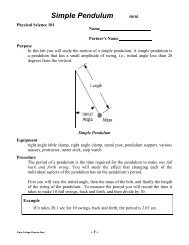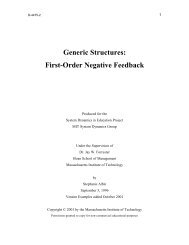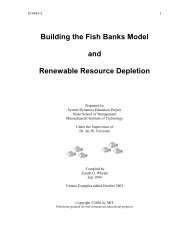Unexpected Behaviors in Higher- Order Positive Feedback Loops
Order Positive Feedback Loops - Creative Learning Exchange
Order Positive Feedback Loops - Creative Learning Exchange
- No tags were found...
Create successful ePaper yourself
Turn your PDF publications into a flip-book with our unique Google optimized e-Paper software.
D-4455-1 1<strong>Unexpected</strong> <strong>Behaviors</strong> <strong>in</strong> <strong>Higher</strong>-<strong>Order</strong> <strong>Positive</strong> <strong>Feedback</strong> <strong>Loops</strong>Prepared for theMIT System Dynamics <strong>in</strong> Education ProjectUnder the Supervision ofDr. Jay W. ForresterbyAaron C. AshfordMay 8, 1995Vensim Examples added October 2001Copyright © 2001 by the Massachusetts Institute of TechnologyPermission granted to copy for non-commercial educational purposes
2 D-4455-2
D-4455-2 3Table of Contents1. ABSTRACT 62. INTRODUCTION 73. UNEXPECTED BEHAVIORS 83.1 FIRST-ORDER LOOP 83.2 SECOND-ORDER LOOP 93.3 THIRD-ORDER LOOP 133.4 FOURTH-ORDER LOOP 164. SUMMARY 195. APPENDIX A: SOME SOLUTIONS TO EXPLORATIONS 205.1 SECOND-ORDER SYSTEM 205.2 THIRD-ORDER SYSTEM 215.3 FOURTH-ORDER SYSTEM 235.4 FIFTH-ORDER SYSTEM 236. APPENDIX B: MODEL EQUATIONS 246.1 FIRST-ORDER LOOP 246.2 SECOND-ORDER LOOP 246.3 THIRD-ORDER LOOP 246.4 FOURTH-ORDER LOOP 246.5 FIFTH-ORDER LOOP 246. VENSIM EXAMPLES 25
4 D-4455-2
D-4455-2 5
6 D-4455-2ABSTRACT<strong>Positive</strong> feedback loops typically show the behavior of exponential growth.However, simple unbounded growth is not the only behavior a s<strong>in</strong>gle loop is able toexhibit. Other possible behaviors <strong>in</strong>clude: exponential decay, damped oscillation,susta<strong>in</strong>ed oscillation, and expand<strong>in</strong>g oscillation. Each of these additional behavior modesis unstable, and each will turn to exponential growth if perturbed out of the stable mode.This paper demonstrates and explores these unexpected behaviors <strong>in</strong> simple positivefeedback loops. The loops used for experimentation are all elementary, with directpositive <strong>in</strong>fluences and no m<strong>in</strong>or loops. The loops vary from first to fourth order.
D-4455-2 71. INTRODUCTIONWe naturally expect positive feedback to grow exponentially. It is the behavior weexperience daily. Our sav<strong>in</strong>gs accounts gather <strong>in</strong>terest, as do our debts from loans, andtypically at an alarm<strong>in</strong>g rate. The world population is explod<strong>in</strong>g about us, and the AIDSepidemic quickly spreads with<strong>in</strong> it. The level of technology doubles every few years.Unchecked nuclear explosions power the sun, which gives us the energy we live by. In allof these examples, the rule is simple: the more you’ve got, the faster you get it. Thisbehavior is a part of any system whose rate of advancement is directly dependent on thelevel of its current state— what is commonly called positive feedback. Thus we expectloop structures that have positive <strong>in</strong>fluences between its connections to quickly growwithout bound— exponentially.However, simple unbounded growth is not the only behavior a s<strong>in</strong>gle loop is ableto exhibit. Other possible behaviors <strong>in</strong>clude: exponential decay, damped oscillation,susta<strong>in</strong>ed oscillation, and expand<strong>in</strong>g oscillation. These are behaviors that we expect to see<strong>in</strong> negative feedback loops; they are signs of stability. As we shall see, <strong>in</strong> positivefeedback loops each of these behavior modes is unstable, and each will turn to exponentialgrowth if perturbed out of the uncharacteristic mode.To help ga<strong>in</strong> a better understand<strong>in</strong>g of this special k<strong>in</strong>d of behavior, we willexperiment with simple loops only. Each level <strong>in</strong> a loop will have a direct positive<strong>in</strong>fluence on the rate of the next level. There will be no other <strong>in</strong>puts to the rates. Inaddition, our <strong>in</strong>vestigation will start with a second-order loop, and we will <strong>in</strong>creasecomplexity one level at a time. To explore the behavior of each loop, we will change the<strong>in</strong>itial conditions of the level variables, but we will not alter the model structure. Althoughchang<strong>in</strong>g the structure leads to a wealth of <strong>in</strong>terest<strong>in</strong>g <strong>in</strong>vestigations, there will be nochanges to the rate equations. I recommend that the reader, while proceed<strong>in</strong>g through thepaper, build each model <strong>in</strong>dependently and experiment with it freely.
8 D-4455-22. UNEXPECTED BEHAVIORS2.1 First-<strong>Order</strong> LoopRateLevel+Figure 1: A first-order positive feedback loopWe are familiar with the simple first-order positive feedback loop (Figure 1). Inthe most simple case Rate = Level. In that case, if Level is positive, and thus Rate ispositive, then the rate <strong>in</strong>creases the level, and the level <strong>in</strong> turn <strong>in</strong>creases the rate, further<strong>in</strong>creas<strong>in</strong>g the level, and so on. This process yields exponential growth, the result ofstandard positive feedback. Likewise, if the level and the rate start off negative, then therate decreases the level, mak<strong>in</strong>g the level more negative, mak<strong>in</strong>g the rate more negative,which further decreases the level, and so on— aga<strong>in</strong> we have positive feedback, now <strong>in</strong> thedirection towards very negative numbers.In both cases there is the re<strong>in</strong>forc<strong>in</strong>g pattern. In a specific model the loop mayhave many additional factors affect<strong>in</strong>g it, depend<strong>in</strong>g on the system be<strong>in</strong>g modeled (birthfraction, <strong>in</strong>terest rate, and learn<strong>in</strong>g ability are a few possibilities). However, it will alwaysexhibit the behavior of exponential growth. The same, however, cannot be said of higherorderpositive feedback loops.
D-4455-2 9+a+x++b. . .+c+Figure 2: <strong>Positive</strong> <strong>Feedback</strong>In higher-order positive feedback loops, exponential growth is not alwaysexhibited, and unexpected behavior modes do appear. This may seem surpris<strong>in</strong>g,especially after look<strong>in</strong>g at a causal loop representation of a positive feedback loop (Figure2). If a <strong>in</strong>creases b and b <strong>in</strong>creases c and ... and x <strong>in</strong>creases a, then shouldn't everyth<strong>in</strong>g<strong>in</strong>crease (or decrease to very negative numbers) together? Shouldn't everyth<strong>in</strong>g growtogether, faster and faster, exponentially? Usually, yes, but not always.For example, look aga<strong>in</strong> at the first-order model above. If the level is <strong>in</strong>itially 0,then it will stay forever 0. This is because the rate is also 0, as specified <strong>in</strong> the rateequation. Thus no change takes place. Even though the model is <strong>in</strong> equilibrium, it is <strong>in</strong> anunstable balance. If the value of the level is changed the slightest bit <strong>in</strong> either direction,then the behavior will slip <strong>in</strong>to exponential growth. This is what is meant by an unstableequilibrium. The higher-order models we will see have similarly unstable behavior modes.2.2 Second-<strong>Order</strong> LoopWe now exam<strong>in</strong>e the simplest second-order positive feedback loop possible(Figure 3). The rate of level a, da, is equal to the value of level b. Likewise, the rate oflevel b, db, is equal to the value of level a. (Note: the system equations for all models canbe found <strong>in</strong> Appendix B.)Once aga<strong>in</strong>, the model structure will not be altered. We will only change the <strong>in</strong>itialvalues of a and b.
10 D-4455-2First note that when a = b = 0, the rate of change for both level a and b is 0; thusthe system is <strong>in</strong> equilibrium, much the same as with the first-order model. Now let a(0) =b(0) = 1 (this notation simply means that we are sett<strong>in</strong>g the <strong>in</strong>itial condition, whentime=0, of both levels to 1). We have moved the system out of equilibrium. It can be<strong>in</strong>tuitively seen now to explode exponentially— standard positive feedback. Level a<strong>in</strong>creases at a rate equal to level b. Because <strong>in</strong>itially a=b, b <strong>in</strong>creases at the same rate. Infact, a and b push each other identically; they behave as one, grow<strong>in</strong>g faster and fastertogether.a+dabdb+Figure 3: Second-order positive feedback loop
D-4455-2 115.00a(0)=2a(0)=1a(0)=00.00a(0)=-2-5.000.00 1.25 2.50 3.75 5.00TimeFigure 4: Exponential behavior from four different <strong>in</strong>itial conditions (second-orderpositive feedback loop). b(0) = 1 <strong>in</strong> all cases.Leave b(0) = 1 and try a(0) = 2, then a(0) = 0. In both cases the level that is<strong>in</strong>itially greater stays greater, and the levels aga<strong>in</strong> escape to positive <strong>in</strong>f<strong>in</strong>ity. Next, leta(0) = -2. This time a is sufficiently negative to reverse the direction of escape. aconsistently decreases b by more than b <strong>in</strong>creases a; eventually b drops below 0, and botha and b plummet. Figure 4 shows the time series of a for the above four cases.All of these show the expected exponential behavior, some up and some down.But there is a balance between them. Let a(0) = -1. Now b is decreased by a at the samerate a is <strong>in</strong>creased by b. The two ride <strong>in</strong> a perfect balance, asymptotically approach<strong>in</strong>g 0(Figure 5). This behavior would occur for any <strong>in</strong>itial conditions a(0) = -b(0). Thisbehavior is usually seen <strong>in</strong> first-order negative feedback, which shows an approach tostable equilibrium. However, this is not a stable behavior mode. The slightest change <strong>in</strong>either variable destabilizes the approach and returns both to an exponential growth. Thisis seen <strong>in</strong> Figure 6 where we let a(0) = -0.99, a 1% disturbance.Although exponential growth is the dom<strong>in</strong>ant behavior, it is possible to elicitasymptotic approach to (unstable) equilibrium <strong>in</strong> a purely positive second-order loop.
12 D-4455-22.001: a 2: b2b(0)=10.001a(0)=-121 2 1 21-2.000.00 1.50 3.00 4.50 6.00TimeFigure 5: Convergent behavior from <strong>in</strong>itial conditions a(0) = -1, b(0) = 1(second-order positive feedback loop).2.001: a 2: b0.002b(0)=12 211a(0)=-0.99121-2.000.00 1.50 3.00 4.50 6.00TimeFigure 6: Unstable convergence perturbed to exponential growth(second-order positive feedback loop).Independent Exploration:Make a comparative scatter graph of a vs. b, and try many <strong>in</strong>itial values of a andb. This is done <strong>in</strong> the Graph Pad Dialog box. First, select Scatter under Graph Type.Then double click a and b under Allowable to be Selected, as normally done. To plot
D-4455-2 13many <strong>in</strong>itial values on the same graph, you must first check Comparative beforeidentify<strong>in</strong>g the Selected variables. What pattern emerges?Introduce time constants as an additional <strong>in</strong>put to the rate equations (i.e. da =b/ta, db = a/tb, where ta and tb are the time constants). These time constants arepresent <strong>in</strong> the loops already described above; they are simply equal to 1 and so have noeffect. How does chang<strong>in</strong>g the time constants affect the system? How about negativetime constants (and can you imag<strong>in</strong>e what such a th<strong>in</strong>g might mean)?2.3 Third-<strong>Order</strong> LoopThe third-order system be<strong>in</strong>g exam<strong>in</strong>ed is, like the second-order system, thesimplest possible. Each level feeds the rate of the next with no other <strong>in</strong>put (Figure 7).a+cdab+dc+dbFigure 7: Third-order positive feedback loopThis system can also produce exponential growth from many <strong>in</strong>itial conditions(E.g. a(0) = b(0) = c(0) = 1), but we will jump directly to other behavior modes. Let
14 D-4455-2a(0) = 1, b(0) = -1, and c(0) = 0. This produces the surpris<strong>in</strong>g behavior <strong>in</strong> Figure 8.Here we see, <strong>in</strong>stead of exponential growth or even decay, damped periodic oscillations!Here, as <strong>in</strong> the second-order system, we have found a balanced state. The levels,<strong>in</strong> this balance, can not decide whether to escape up or down, and so they do neither. Butaga<strong>in</strong>, this apparently stable approach to equilibrium— for when a=b=c=0 the system is <strong>in</strong>equilibrium— is not truly stable at all. Change one value only slightly, by a scant 1/1000,and the balance collapses as <strong>in</strong> Figure 9.Where does this periodic behavior come from? There is no negative feedback todrive it directly. There are no exogenous <strong>in</strong>puts. There are, however, three delays. Theseare not delays <strong>in</strong> the traditional sense, where an <strong>in</strong>terven<strong>in</strong>g level may change a step<strong>in</strong>crease <strong>in</strong>flow <strong>in</strong>to a smoothed outflow (us<strong>in</strong>g additional negative feedback structure).The delays are present <strong>in</strong>herently with<strong>in</strong> the levels. To see this, notice what happens whena rate suddenly changes. If we are look<strong>in</strong>g only at the level changed by this rate, the surgeis not immediately felt— at least not strongly. After some time passes by, we may noticethat the level is chang<strong>in</strong>g <strong>in</strong> a new way, due to a new rate value. However, the<strong>in</strong>formation pass<strong>in</strong>g through the rate and then the level still has this <strong>in</strong>herent delay. Ittakes time for qualitative behavior to propagate through.Thus, while b is <strong>in</strong>creas<strong>in</strong>g from the start, the effect does not have a strong effecton a until approximately time = 2, <strong>in</strong> the previous example. The delays— and the balanceof the levels around 0— <strong>in</strong>cite the oscillations. The oscillations occur <strong>in</strong> the third-ordersystem and not the second-order system because the higher order system has more roomfor dynamic behavior; there are not enough delays present <strong>in</strong> the second-order system. Sowhat might we see <strong>in</strong> systems of even higher orders?Independent Exploration:Aga<strong>in</strong>, create comparative scatter graphs, this time of a vs. b, a vs. c, and b vs. c.In this way you can beg<strong>in</strong> to see a three dimensional picture of the behavior (<strong>in</strong> the spaceof a, b, and c). The three graphs give you perspectives that we might call front, side, andtop. What do you see now, and how does it compare to what you saw <strong>in</strong> the secondordersystem?
D-4455-2 15The balance for convergent behavior <strong>in</strong> the third-order system occurs when a(0) +b(0) + c(0) = 0. Can you discover why?2.001: a 2: b 3: c1a(0)=1b(0)=-10.00212312 3 1 2 33c(0)=0-2.000.00 3.00 6.00 9.00 12.00TimeFigure 8: Convergent periodic oscillations(third-order positive feedback loop).2.001: a 2: b 3: c0.00a(0)=112b(0)=-11231231233c(0)=0.001-2.000.00 3.00 6.00 9.00 12.00TimeFigure 9: Convergent periodic oscillations destabiliz<strong>in</strong>g to exponential growth(third-order positive feedback loop)
16 D-4455-22.4 Fourth-<strong>Order</strong> LoopThe fourth-order system is identical to the previous systems except for that it addsone more level to the cha<strong>in</strong> (Figure 10).What surpris<strong>in</strong>g behavior can we obta<strong>in</strong> with<strong>in</strong> the freedom of four level variables?As it happens, three dist<strong>in</strong>ct modes appear. The expected divergent exponential (a(0) =b(0) = c(0) = d(0) = 1) and convergent decay (a(0) = c(0)=1, b(0) = d(0) = -1) wehave seen already, but— as unbelievable as it may seem— we can now also have susta<strong>in</strong>edoscillations! With only positive feedback between the <strong>in</strong>dividual variables— and with the<strong>in</strong>itial conditions properly balanced— the delays between distant levels is great enough tocreate susta<strong>in</strong>ed oscillations. In Figure 11 a(0) = 1, b(0) = -1, and c(0) = d(0) = 0.(You may get expand<strong>in</strong>g oscillations when you simulate this. If so, it is due only to DTerror, and it can be rectified by us<strong>in</strong>g a different <strong>in</strong>tegration method or a smaller DT. Iused DT=0.01; Runge-Kutta at DT=0.1 works just as well.)As is the case <strong>in</strong> the other systems, this peculiar behavior mode is not stable. A1/1000 perturbation— chang<strong>in</strong>g c(0)=0.001— creates the destabilization <strong>in</strong> Figure 12.ab+dbda++ddcdd+cFigure 10: Fourth-order positive feedback loop
D-4455-2 17Fourth-order feedback has the flexibility and <strong>in</strong>herent delay to foster susta<strong>in</strong>edoscillations, as well as convergence to an unstable equilibrium. This system might beviewed as tak<strong>in</strong>g a two-level oscillat<strong>in</strong>g system and "hid<strong>in</strong>g" it with<strong>in</strong> the second-ordersystem seen earlier; their behaviors together form the behavior we see here.Independent Exploration:Look closely at the time-series for each of the feedback loops exam<strong>in</strong>ed. In thesecond and third-order systems, the convergent behavior mode died out when it wasperturbed <strong>in</strong>to destabilization (given a little push, it blew up). The damped oscillationsturned <strong>in</strong>to (nearly) pure exponential growth. After destabilization (as <strong>in</strong> Figure 12), dothe susta<strong>in</strong>ed oscillations disappear <strong>in</strong> the fourth-order system as well? (You may f<strong>in</strong>d thegeometries constructed from the scatter graphs useful <strong>in</strong> explor<strong>in</strong>g this question.)The fifth-order system offers still greater behavior. Explore and see what you canf<strong>in</strong>d. Under special <strong>in</strong>itial conditions, it will show damped oscillations, but I’ll warn you,they are quite difficult to f<strong>in</strong>d (it took me half a year)!
18 D-4455-22.001: a 2: b 3: c 4: da(0)=11c(0)=0341340.0023b(0)=-141d(0)=0223412-2.000.00 3.00 6.00 9.00 12.00TimeFigure 11: Susta<strong>in</strong>ed oscillations with<strong>in</strong> afourth-order positive feedback loop2.001: a 2: b 3: c 4: d1a(0)=1c(0)=0.0013410.002b(0)=-134d(0)=012 234-2.000.00 3.00 6.00 9.00 12.00TimeFigure 12: Susta<strong>in</strong>ed oscillations destabiliz<strong>in</strong>g to exponential growth(fourth-order positive feedback loop)
D-4455-2 193. SUMMARYAlthough positive feedback loops are usually associated with exponential growth,that is not the only behavior possible with<strong>in</strong> them. Convergence and oscillation can alsobe found. We looked at four different positive feedback loops.The first order loop only behaves exponentially. All <strong>in</strong>itial conditions will re<strong>in</strong>forcethe system state, and push it out to <strong>in</strong>f<strong>in</strong>ity (be it up or down). The only exception is thedegenerate behavior at the orig<strong>in</strong>. There it stays fixed at one po<strong>in</strong>t, but note that thisspecial behavior, like <strong>in</strong> the other systems, is unstable. Exponential growth is still thestable behavior.The second order loop showed that exponential growth was not the onlypossibility for positive loops. While <strong>in</strong> perfect balance, the two levels settled to unstableequilibrium. Notice that the fixed behavior of the orig<strong>in</strong> is still present (and unstable).The higher— order positive feedback loops conta<strong>in</strong> many repeated behaviors.The third order loop brought us an <strong>in</strong>terest<strong>in</strong>g twist: oscillations! As <strong>in</strong> thesecond order loop, the levels had to be <strong>in</strong> a special balance, but this time their decent toequilibrium was done with a rhythmic dance.The fourth order loop, the f<strong>in</strong>al loop exam<strong>in</strong>ed, went a step further than the thirdand produced stable oscillations. This result clearly demonstrated the surpris<strong>in</strong>g characterof positive feedback. A feedback loop that has, at each <strong>in</strong>dividual step, only positive<strong>in</strong>fluences can produce behavior that is undeniably negative <strong>in</strong> appearance.We have found great behavioral diversity even with<strong>in</strong> the simplest of positiveloops. The truly stable behavior <strong>in</strong> each case is exponential growth. It is stable <strong>in</strong> thatsmall perturbations do not change the behavior greatly, and yet it is unstable <strong>in</strong> that itsbehavior looks most unsettled. On the other hand, the other behaviors we have seen areunstable because small perturbations do drastically change their behavior, even thoughthey all give the appearance of stability. We can almost always f<strong>in</strong>d unusual unstablebehavior disguised as what truly would be stable <strong>in</strong> other models.As it happens, the behaviors we have seen here demonstrate all the possibilitiesthat models of this simple nature can exhibit. Remember that most models of the realworld are not nearly so constra<strong>in</strong>ed or simplified as what we have seen <strong>in</strong> this paper. Mostpositive feedback loops <strong>in</strong> real world models will show (for the most part) only
20 D-4455-2exponential growth. But still keep <strong>in</strong> m<strong>in</strong>d that unexpected behaviors are possible, evenlikely, and they are bound to be quite complex.4. APPENDIX A: SOME SOLUTIONS TO EXPLORATIONS4.1 Second-order SystemMake a comparative scatter graph of a vs. b, and try many <strong>in</strong>itial values of aand b; what pattern emerges?This geometric pattern (shown <strong>in</strong> Figure 13.) is called a saddle. To see why it isgiven this name, imag<strong>in</strong>e lett<strong>in</strong>g a marble roll off an actual horse saddle. It moves alongthe surface, fall<strong>in</strong>g down the sides where one’s legs would normally go. If you were ableto place the marble just right, you could balance it <strong>in</strong> the center of the saddle, and it wouldnot fall <strong>in</strong> either direction. If you were even more careful, you could place the marble nearthe top of the saddle, still centered left and right, and it would roll down to the center, butnot fall to either side. If the saddle were sticky, then the marble would also slow to a stopat the center, just as we have <strong>in</strong> our saddle here. The two orbits with <strong>in</strong>itial conditions (-3,3) and (2, -2) are <strong>in</strong> a balanced path along the saddle. They exponentially approach theorig<strong>in</strong>, while orbits to either side quickly zoom off to <strong>in</strong>f<strong>in</strong>ity.
D-4455-2 215.001-10: a v . b0.00-5.00-5.00 0.00 5.00aFigure 13: Paths on a saddle from 10 different <strong>in</strong>itial conditions4.2 Third-order SystemWhat do you see <strong>in</strong> the new scatter plots, and how does it compare to what yousaw <strong>in</strong> the second-order system?This pattern is significantly more complicated to look at than the saddle. Theproblem is, it is a three-dimensional pattern. Figure 14 shows what it looks like from oneperspective. The best way for you to see it is probably to watch it as the simulation runs,flipp<strong>in</strong>g between perspectives.
D-4455-2 234.3 Fourth-order SystemAfter destabilization, do the susta<strong>in</strong>ed oscillations disappear <strong>in</strong> the fourth-ordersystem as well?No, the oscillations cont<strong>in</strong>ue, even while rocket<strong>in</strong>g off to <strong>in</strong>f<strong>in</strong>ity. The way topicture this is to use the geometries just shown for the second and third-order systems.The pattern now is even more complicated, and now it is <strong>in</strong> four dimensions! For thisreason, I won’t try to show it to you here, although I applaud all those who try to makesense out of the scatter graphs.The way to th<strong>in</strong>k about it is to picture the orbits as travel<strong>in</strong>g around a cyl<strong>in</strong>der. Atthe plane cutt<strong>in</strong>g through the cyl<strong>in</strong>der and the orig<strong>in</strong>, the orbits go round and round <strong>in</strong> acircle. This is the susta<strong>in</strong>ed oscillations. Above and below this plane, the orbit fly away,but they cont<strong>in</strong>ue to spiral around the cyl<strong>in</strong>der. So, even though they become more andmore drowned out by the exponential growth, the oscillations do not disappear.The way to check it is to see what happens to the differences between the levelvariables. Plot a time series of a-b, for example. This should oscillate even whileexplod<strong>in</strong>g exponentially.4.4 Fifth-order SystemCan you f<strong>in</strong>d the <strong>in</strong>itial condition (for the fifth-order system) that results <strong>in</strong> decayedoscillations?Here it is. Try it out, and look at nearby po<strong>in</strong>ts too.a=1 c=cos(2p/5) e= -cos(p/5)b= -cos(p/5) d=cos(2p/5)
D-4455-1 25Vensim Examples:<strong>Unexpected</strong> <strong>Behaviors</strong> <strong>in</strong> <strong>Higher</strong>-<strong>Order</strong> <strong>Positive</strong><strong>Feedback</strong> <strong>Loops</strong>Aaron Diamond3.1 First-<strong>Order</strong> LoopOctober 2001Levelrate +INITIAL LEVELFigure 15: Vensim Equivalent of Figure 1: A first-order positive feedback loopDocumentation for first-order positive feedback loop(1) FINAL TIME = 6Units: noneThe f<strong>in</strong>al time for the simulation.(2) INITIAL LEVEL=1Units: **undef<strong>in</strong>ed**(3) INITIAL TIME = 0Units: noneThe <strong>in</strong>itial time for the simulation.(4) Level= INTEG (Rate, INITIAL LEVEL)Units: **undef<strong>in</strong>ed**
26 D-4455-2(5) rate=LevelUnits: **undef<strong>in</strong>ed**(6) SAVEPER = TIME STEPUnits: noneThe frequency with which output is stored.(7) TIME STEP = 0.0625Units: noneThe time step for the simulation.3.2 Second-<strong>Order</strong> LoopAda+INITIAL AB+dbINITIAL BFigure 16: Vensim Equivalent of Figure 3: Second-order positive feedback loopDocumentation for second-order positive feedback loop(1) A= INTEG (da, INITIAL A)Units: **undef<strong>in</strong>ed**(2) B= INTEG (db, INITIAL B)Units: **undef<strong>in</strong>ed**(3) da=B
D-4455-2 27Units: **undef<strong>in</strong>ed**(4) db=AUnits: **undef<strong>in</strong>ed**(5) FINAL TIME = 6Units: noneThe f<strong>in</strong>al time for the simulation.(6) INITIAL A=1Units: **undef<strong>in</strong>ed**(7) INITIAL B=1Units: **undef<strong>in</strong>ed**(8) INITIAL TIME = 0Units: noneThe <strong>in</strong>itial time for the simulation.(9) SAVEPER = TIME STEPUnits: noneThe frequency with which output is stored.(10) TIME STEP = 0.0625Units: noneThe time step for the simulation.
28 D-4455-25A(0)=2Graph of Exponential BehaviorA(0)=1A(0)=00A(0)=-2-50 1 2 3 4 5 6TimeFigure 17: Vensim Equivalent of Figure 4: Exponential behavior from four different<strong>in</strong>itial conditions (second-order positive feedback loop). B(0)=1 <strong>in</strong> all cases.2Graph of Convergent Behavior10-112B(0)=1A(0)=-12 2 1 21 1-20 1 2 3 4 5 6TimeA: -------------------------------------------------------------- 1 1 1 unitsB: -------------------------------------------------------------- 2 22 unitsFigure 18: Vensim Equivalent of Figure 5:Convergent behavior from <strong>in</strong>itial conditionsA(0)=-1, B(0)=1 (second order positive loop).
D-4455-2 292Graph of Unstable Convergence10-112B(0)=11A(0)=-.992 2112-20 1 2 3 4 5 6TimeA: --------------------------------------------------------------------- 111unitsB: --------------------------------------------------------------------- 222 unitsFigure 19: Vensim Equivalent of Figure 6: Unstable convergence perturbed to exponentialgrowth (second-order positive feedback loop).
30 D-4455-23.3 Third-<strong>Order</strong> LoopINITIAL C+daAINITIAL ACdc++BdbINITIAL BFigure 20: Vensim Equivalent of Figure 7: Third-order positive feedback loop.Documentation for third-order positive feedback loop(01) A= INTEG (da, INITIAL A)Units: **undef<strong>in</strong>ed**(02) B= INTEG (db, INITIAL B)Units: **undef<strong>in</strong>ed**(03) C= INTEG (dc, INITIAL C)Units: **undef<strong>in</strong>ed**(04) da=CUnits: **undef<strong>in</strong>ed**(05) db=AUnits: **undef<strong>in</strong>ed**
D-4455-2 31(06) dc=BUnits: **undef<strong>in</strong>ed**(07) FINAL TIME = 12Units: noneThe f<strong>in</strong>al time for the simulation.(8) INITIAL A=1Units: **undef<strong>in</strong>ed**(9) INITIAL B=-1Units: **undef<strong>in</strong>ed**(10) INITIAL C=0Units: **undef<strong>in</strong>ed**(11) INITIAL TIME = 0Units: noneThe <strong>in</strong>itial time for the simulation.(12) SAVEPER =TIME STEPUnits: noneThe frequency with which output is stored.(13) TIME STEP = 0.0625Units: noneThe time step for the simulation.
32 D-4455-22Graph of Convergent Periodic Oscillations1A(0)=10-121B(0)=-1213C(0)=03 1 32123-20 1 2 3 4 5 6 7 8 9 10 11 12TimeA: ---------------------------------------------------------------------- 1 1 1units22 2B: -----------------------------------------------------------------------units3 3C: -----------------------------------------------------------------------units3Figure 21: Vensim Equivalent of Figure 8: Convergent periodic oscillations (third-orderpositive feedback loop).Graph of Destabiliz<strong>in</strong>g Convergent Periodic Oscillations230A(0)=11B(0)=-12 23 1312312C(0)=0.0001-20 1 2 3 4 5 6 7 8 9 10 11 12TimeA: ------------------------------------------------------------------- 111units222B: ------------------------------------------------------------------- units333C: ------------------------------------------------------------------- unitsFigure 22: Vensim Equivalent 1 of Figure 9: Convergent periodic oscillations destabiliz<strong>in</strong>gto exponential growth (third-order positive feedback loop).
D-4455-2 333.4 Fourth-<strong>Order</strong> LoopAINITIAL AINITIAL B+dbBda+dc+Ddd+CINITIAL DINITIAL CFigure 23: Vensim Equivalent of Figure 10: Fourth-order positive feedback.Documentation for fourth order feedback loop(01) A= INTEG (da, INITIAL A)Units: **undef<strong>in</strong>ed**(02) B= INTEG (db, INITIAL B )Units: **undef<strong>in</strong>ed**(03) C= INTEG (dc, INITIAL C)Units: **undef<strong>in</strong>ed**(04) D= INTEG (dd, INITIAL D)Units: **undef<strong>in</strong>ed**(05) da=DUnits: **undef<strong>in</strong>ed**
34 D-4455-2(06) db=AUnits: **undef<strong>in</strong>ed**(07) dc=BUnits: **undef<strong>in</strong>ed**(08) dd=CUnits: **undef<strong>in</strong>ed**(09) FINAL TIME = 12Units: noneThe f<strong>in</strong>al time for the simulation.(10) INITIAL A=1Units: **undef<strong>in</strong>ed**(11) INITIAL B=-1Units: **undef<strong>in</strong>ed**(12) INITIAL C=0Units: **undef<strong>in</strong>ed**(13) INITIAL D=0Units: **undef<strong>in</strong>ed**(14) INITIAL TIME = 0Units: noneThe <strong>in</strong>itial time for the simulation.(15) SAVEPER = TIME STEP
D-4455-2 35Units: noneThe frequency with which output is stored.(16) TIME STEP = 0.015625Units: noneThe time step for the simulation.2Graph of Susta<strong>in</strong>ed Oscillations0A(0)=112B(0)=-134D(0)=0C(0)=01234 1 2 3 4-20 1 2 3 4 5 6 7 8 9 10 11 12TimeA: 1--------------------------------------------------------- 11units2B: ---------------------------------------------------------2 2units3 33C: --------------------------------------------------------- 44 4 unitsFigure 24: Vensim Equivalent of Figure 11: Susta<strong>in</strong>ed oscillations with<strong>in</strong> a fourth-orderpositive feedback loop.
36 D-4455-220-2A(0)=1Graph of Destabiliz<strong>in</strong>g Susta<strong>in</strong>ed OscillationsB(0)=-11234D(0)=0C(0)=.00112340 1 2 3 4 5 6 7 8 9 10 11 12Time (none)1234A: -------------------------------------------------- 111 unitsB: --------------------------------------------------2 22units333C: -------------------------------------------------- 44 4 unitsFigure 25: Vensim Equivalent of Figure 12: Susta<strong>in</strong>ed oscillations destabiliz<strong>in</strong>g toexponential growth (fourth-order positive feedback loop).


